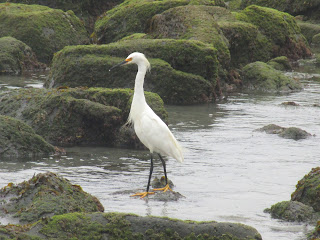Wednesday, 12 July 2017
The snowy egret is such a beautiful, graceful bird, even on land. I think we both are delighted every time we see them. When we first got here, we saw only one bird on the beach. It is great to see four at a time now. Even two together feels right.
This picture is a first for us. We caught a picture of the snowy egret with a fish in its mouth.
This little monster is not an alien from outer space. It is a shore crab. Apparently , I have gone through life misnaming this amazing little creature. It is not a sand or a rock crab. The description on one site says the shore crab is striped and that rock crabs are the type you eat at a restaurant. However, I have never seen a striped one like the one below.
SHORE CRAB – PACHYGRAPSUS CRASSIPES These common crabs to any southern California rocky environment have a range from Oregon to Baja and can grow to 1 ¾” wide at the carapace. The crabs can be found underwater in tidepools, hidden in rockweed beds, or deep in the back of a crevice. Their primary food is algae, but they have been known to feed on diatoms, hermit crabs, gastropods and have even been known to catch kelp flies with their claws
Stripes Shore Crab – ( Pachygrapsus crassipes )
Cliffs by above the tide pools
This week surfers here are benefiting from the remnants of a hurricane off Mexico.
The waves are supposed to be higher than usual. The shoreline has been covered with bodies in black wetsuits hoping to catch that perfect wave. We definitely have seen more surfers trying to catch that wave than usual. The norm is that the black figures just sit on their boards.
http://solspot.com/la-jolla-shores-surf-report/
Heavy surf is expected along much of the Southern California coast and beachgoers are warned of dangerous waves and rip currents.
The swells are generated by former Hurricane Eugene, which is now a tropical storm off the coast of Baja California.
Wednesday, July 12, 2017, 1:38 - Tropical Storm Eugene continues to track northeast parallel to the coast of Baja California, Mexico and is expected to weaken into a low by the end of the day Wednesday, according to the National Hurricane Center.
In the meantime, the storm is expected to continue generating large waves along the coast of Baja, but high surf and dangerous rip currents are also expected along much of the Southern California coastline from San Diego to Santa Barbara.

SEA HARE – APLYSIA CALIFORNICA This marine snail varies in reddish to brown coloration, can grow up to 16” in length and is found from the low intertidal to 60’ of water. Sea hares derive their name from the two antennae that is said to resemble rabbit’s ears. These snails forage on red algae, and use the pigments to create its defense mechanism. When Aplysia are disturbed they excrete a purple ink that may confuse, paralyze or offend its predator. Sea hares are hermaphrodites, having both male and female organs, but must locate a mate to reproduce. These critters have been used extensively in nerve research due to the large size of their ganglia (nerve styles).
|
According to the man holding the Sea Hare, among these rocks is a beach seal pup. Neither of us could see it. Maybe it is our eyes. When we walked back along the beach we saw a woman stop at the top of the rocks and watch for a very long time. We decided she must have seen the seal.
Let me know if you can spot a tiny baby seal among all of these rocks.
Enlarging the pictures and using a magnifying glass did not help me at all.
Of course, those are my two surfboards behind me.
Thursday, 13 July 2017
We think that this fish lying at the bottom of the tidepool is actually alive. It was higher on the rocks when we first looked at the pool and it seemed to tumble down the side and come to rest on the bottom of the pool. Once in awhile I think I saw it move its head.
This is one little fish that we see occasionally in the tide pools. They are hard to spot unless they move. We have never seen one longer than about 1 1/2 inches. One of their interesting characteristics is that they look as if they are crawling along the bottom of the pool rather than swimming.
It has been awhile since we have seen the tide out this far. However, it still did not have "dry" land so that we could walk to the other side of the tunnel in the rock.
| ||||||||||||||||||||||
Description | ||||||||||||||||||||||
| These animals have been called sea hares since classical times because of their resemblance - at least in a European species - to a sitting hare or rabbit. The sea hare is a slug complete with a small internal shell. It can grow up to the size of a football and it can be | ||||||||||||||||||||||
When you look at anemone on sites on the computer, they are always such bright beautiful colors. These are the ones that are in the tide pool where we walk. As you can see they are covered with shells as camouflage.
Sea Anemone with sculpin fish
The information on this page says that there are 5 sculpin fish in the photo
Diadumeme Lineata or Sea Anemone Photographer Peter Bryant
We were surprised to see this huge crane hanging over a beach house. We could not tell which house it was being used at and could not guess what it could be for.
Photographer Peter Bryant
Opaleye ( Girella nigricans )
Is the opaleye the small black fish that we see darting back and forth in the pools? Hmmm










































No comments:
Post a Comment